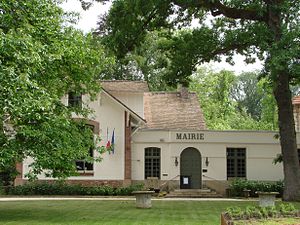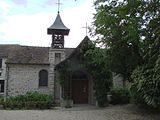Barbizon
| Barbizon | ||
|---|---|---|

|
|
|
| region | Île-de-France | |
| Department | Seine-et-Marne | |
| Arrondissement | Fontainebleau | |
| Canton | Fontainebleau | |
| Community association | Pays de Fontainebleau | |
| Coordinates | 48 ° 27 ' N , 2 ° 36' E | |
| height | 75-93 m | |
| surface | 5.27 km 2 | |
| Residents | 1,135 (January 1, 2017) | |
| Population density | 215 inhabitants / km 2 | |
| Post Code | 77630 | |
| INSEE code | 77022 | |
| Website | www.barbizon.fr | |
 town hall |
||
Barbizon is a French commune with 1,135 inhabitants (at January 1, 2017) in the department of Seine-et-Marne in the region Ile-de-France . The municipality is located in the Gâtinais français Regional Nature Park .
The name also refers to an artists' colony who lived and worked in this community from around 1830 to around 1870.
Barbizon artists' colony
The Barbizon School , an artists' colony in the Fontainebleau forest , was founded around 1830. The term “Barbizon School of Painting” is misleading in that a school in the sense of a teacher-student relationship never existed. It was not a closed group either, but rather a relaxed circle of friends and colleagues, some of whom settled in Barbizon, others in the Auberge Ganne guesthouse for a while . It was named after the English writer and art dealer David C. Thomson with the book The Barbizon School of Painters , which was published in a limited edition in New York in 1890.
With the invention of the railroad, painters could easily travel from Paris to Barbizon with their easels. Since the tube colors had already been invented, they could now paint directly in the great outdoors. A simple internalized landscape painting ( paysage intime ) was cultivated , which prepared the impressionism . The Barbizonniers looked for new forms of expression in nature and had a great influence on the development of European landscape painting in the 19th century. They also influenced the Worpsweder and Ahrenshooper painters, the Dachau artists' colony and the Skagen painters . Max Liebermann admired the barbizonniers; he stayed in Barbizon during the summer of 1874 and visited Jean-François Millet , whom he valued, shortly before his death.
Barbizon in the 19th century and today
In the 19th century Barbizon consisted only of the main street Rue de Barbizon , today Grande Rue , on which a total of about 40 houses were lined up. The railroad ran along the main road. The only hostel, Auberge Ganne , was in the middle of the village. It has largely been preserved in its original condition and today houses the Musée Ganne ( Musée municipal de l'École de Barbizon - Auberge Ganne ). Barbizon was reached in 90 minutes by train from Paris. Most of the painters rented a room in the Auberge Ganne. Some then bought houses in Barbizon.
Jean-François Millet's house and studio is just 100 meters from the Auberge and is now a private museum. He is buried in the small Barbizon cemetery. The Auberge shows doors, walls and original furniture that was richly painted by the painters in bad weather. Corot, Millet, Rousseau, Troyon, Chaigneau, Brendel and others are represented with original oil paintings.
Principal representative of the Barbizon School
- Jean-Baptiste-Camille Corot (1796–1875)
- Narcisso Virgilio Díaz de la Peña (1807–1876)
- Karl Bodmer (1809-1893)
- Constant Troyon (1810-1865)
- Jules Dupré (1811-1889)
- Théodore Rousseau (1812–1867)
- Charles Emile Jacque (1813-1894)
- Jean-François Millet (1814-1875)
- Gabriel Gervais Chardin (1814–1907)
- Charles-François Daubigny (1817–1878)
- Paul Désiré Trouillebert (1831-1900)
Attractions
See: List of Monuments historiques in Barbizon
literature
- Le Patrimoine des Communes de la Seine-et-Marne . Flohic Editions, Volume 2, Paris 2001, ISBN 2-84234-100-7 , pp. 1197-1202.
Individual evidence
- ^ Sigrid Bertuleit: Max Liebermann and Barbizon: Country life - nature experience. Lower Saxony State Museum Hanover, Hanover 1994.
Web links
- Barbizon at annuaire-mairie.fr (French)
- Community website






